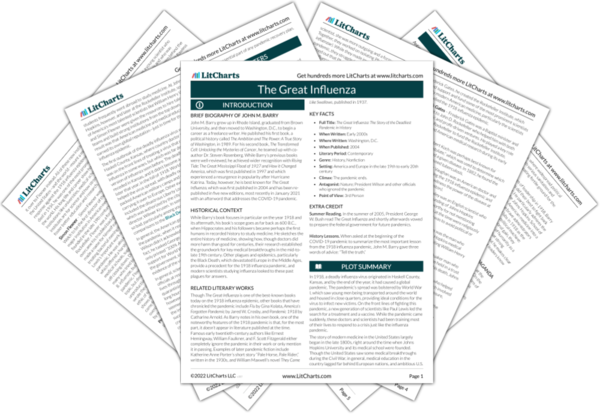Many of the heroes of John Barry’s The Great Influenza are not working alone but as part of laboratories, research institutions, and universities. The early part of the book deals with the founding of Johns Hopkins University and the Rockefeller Institute, two institutions that played a key role in the development of modern American medicine. As Barry shows, one of the reasons why American medicine and medical research lagged so far behind European countries (particularly Germany) for much of the 19th century is that the U.S. lacked strong institutions. Medical schools in the U.S., for example, weren’t standardized or regulated in any meaningful way, which meant that becoming a licensed doctor was often less about skill or knowledge and more about having enough money to pay tuition. Hopkins aimed to change this, and men like William Henry Welch (the first dean of the medical school) knew that one of the first steps to building strong institutions was hiring capable people to run them. One man he worked with, Simon Flexner, would go on to be the first director of the Rockefeller Institute, which used money from the industrialist John D. Rockefeller to build research labs that would finally give American investigators the resources compete with their European counterparts.
The collaborative, collegial nature of these men and their research contrasts sharply with men like Wilmer Krusen. As head of public health in Philadelphia, Krusen caused one of the worst influenza outbreaks in the nation when he refused to heed experts’ warnings about the virus and approved a massive parade that brought many people together in close contact. Even these new American institutions like Hopkins and the Rockefeller Institute weren’t enough to stop the influenza pandemic, but the research they produced helped control the spread and helped scientists draw lessons from the pandemic to use against future diseases. Barry argues in The Great Influenza that modern medical research is costly and complicated but nonetheless important, so it needs strong institutions to foster it. Moreover, he suggests that these institutions need to recruit talented scientists and administrators who will both manage research and train their successors, allowing the institutions to thrive in the long term.
Education, Research, and Institutions ThemeTracker

Education, Research, and Institutions Quotes in The Great Influenza
On September 12, 1876, the crowed overflowing the auditorium of Baltimore’s Academy of Music was in a mood of hopeful excitement, but excitement without frivolity. Indeed, despite an unusual number of women in attendance, many of them from the uppermost reaches of local society, a reporter noted, “There was no display of dress or fashion.” For this occasion had serious purpose. It was to mark the launching of the Johns Hopkins University, an institution whose leaders intended not simply to found a new university but to change all of American education; indeed, they sought considerably more than that.
Ultimately, then, logic and observation failed to penetrate the workings of the body not because of the power of the Hippocratic hypothesis, the Hippocratic paradigm. Logic and observation failed because neither one tested the hypothesis rigorously.
Once investigators began to apply something akin to the modern scientific method, the old hypothesis collapsed.
Nothing about the boyhood or youth of William Henry Welch suggested his future.
American medical education needed a revolution. When the Hopkins medical school did at last open in 1893, most American medical schools had still not established any affiliation with either a teaching hospital or university, most faculty salaries were still paid by student fees, and students still often graduated without ever touching a patient.
The Rockefeller Institute Hospital opened in 1910. By then the best of American medical science and education could compete with the best in the world. But an enormous gap existed in the United States between the best medical practice and the average, and an unbridgeable chasm separated the best from the worst.
As the virus moved, two parallel struggles emerged.
One encompassed all the nation. Within each city, within each factory, within each family, into each store, onto each farm, along the length of the track of the railroads, along the rivers and roads, deep into the bowels of mines and high along the ridges of the mountains, the virus would find its way. In the next weeks, the virus would test society as a whole and each element within it. Society would have to gather itself to meet this test, or collapse.
The other struggle lay within one tight community of scientists. They—men like Welch, Flexner, Cole, Avery, Lewis, Rosenau—had been drafted against their will into a race.
Lewis knew full well that little of what he was doing was good science. It was all, or nearly all, based on informed guesswork. He only worked harder.
As he worked, the society about him teetered on the edge of collapse.
By World War I, the revolution in American medicine led by William Welch had triumphed. That revolution had radically transformed American medicine, forcing its teaching, research, art, and practice through the filter of science.
The greatest questions remained the simplest ones: What caused influenza? What was the pathogen? Was Pfeiffer right when he identified a cause and named it Bacillus influenzae? And if he was not right, then what did cause it? What was the killer?
So the final lesson of 1918, a simple one yet most difficult to execute, is that those who occupy positions of authority must retain the public’s trust. The way to do that is to distort nothing, to put the best face on nothing, to try to manipulate no one.











